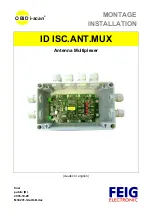
BW
Limit
On
Off
Limits the bandwidth to reduce display noise; filters
the signal to eliminate noise and other unnecessary
HF components.
Invert
On
Off
The invert function turns the displayed waveform 180
degrees, with respect to the ground level. When the
oscilloscope is triggered on the inverted signal, the
trigger is also inverted.
Trigger System
The trigger determines when the oscilloscope begins to acquire data and display a
waveform. Once a trigger is properly set up, the oscilloscope can convert unstable displays
or blank screens to meaningful waveforms.
The triggering mode of this series oscilloscope is edge trigger.
Edge trigger distinguishes the trigger points by seeking the specified edge (rising, falling,
rising & falling) and trigger level.
Press
Trig
button to enter trigger menu.
Trigger Source:
Select the trigger source signal to CH1 or CH2. You can use the trigger
source options to select the signal that the oscilloscope uses as a trigger.
Slope
: Select the trigger slope to rising, falling, rising & falling.
Trigger Mode:
You can select the Auto or Normal mode to define how the oscilloscope
acquires data when it does not detect a trigger condition.
Auto Mode
performs the
acquisition freely in absence of valid trigger. It allows the generation of untriggered
waveforms with the time base set to 100ms/div or slower.
Normal Mode
updates the
displayed waveforms only when the oscilloscope detects a valid trigger condition. Before
this update, the oscilloscope still displays the old waveforms. This mode shall be used
when you want to only view the effectively triggered waveforms. In this mode, the
oscilloscope displays waveforms only after the first trigger. To perform single trigger
acquisition, the trigger mode can be set to "single". When triggered, a single waveform is
acquired and then stop.
Force Trigger:
Used to complete an acquisition regardless of an adequate trigger signal.
This button becomes useless if the acquisition is already stopped.
Trigger Level:
It sets the amplitude level the signal must cross to cause an acquisition
when using the Edge or Pulse Width trigger. Press
Trig
button to enter, and press Up or
Down direction keys to change the trigger level.
63
Summary of Contents for 1760DGT/2
Page 1: ...1760DGT 2 Multimetro digitale con oscilloscopio Manuale d uso 1 ...
Page 44: ...1760DGT 2 Digital multimeter with oscilloscope User Manual 44 ...
Page 75: ...8 Connect Gen Out connector to oscilloscope for observation 75 ...
Page 85: ...1760DGT 2 Multimètre numérique avec oscilloscope Manuel de l Utilisateur 85 ...
Page 117: ...8 Connectez le connecteur Gen Out à l oscilloscope pour l observation 117 ...
Page 127: ...1760DGT 2 Digitalmultimeter mit Oszilloskop Benutzerhandbuch 127 ...
Page 159: ...8 Schließen Sie den Gen Out Stecker zur Beobachtung an das Oszilloskop an 159 ...
Page 169: ...1760DGT 2 Multímetro digital con osciloscopio Manual de usuario 169 ...
Page 200: ...8 Conecte el conector Gen Out al osciloscopio para observación 200 ...
Page 210: ...1760DGT 2 Multímetro digital com osciloscópio Manual do usuário 210 ...
Page 241: ...8 Conecte o conector Gen Out ao osciloscópio para observação 241 ...
Page 251: ...1760DGT 2 Digitale multimeter met oscilloscoop Handleiding 251 ...
Page 282: ...8 Sluit de Gen Out connector aan op de oscilloscoop voor observatie 282 ...
Page 292: ...1760DGT 2 Multimetr cyfrowy z oscyloskopem Instrukcja obsługi 292 ...
Page 323: ...8 Podłączyć złącze Gen Out do oscyloskopu w celu obserwacji 323 ...
Page 333: ...1760DGT 2 Digitális multiméter oszcilloszkóppal Használati utasítás 333 ...
Page 365: ...8 Csatlakoztassa a Gen Out csatlakozót az oszcilloszkóppal megfigyelés céljából 365 ...
















































